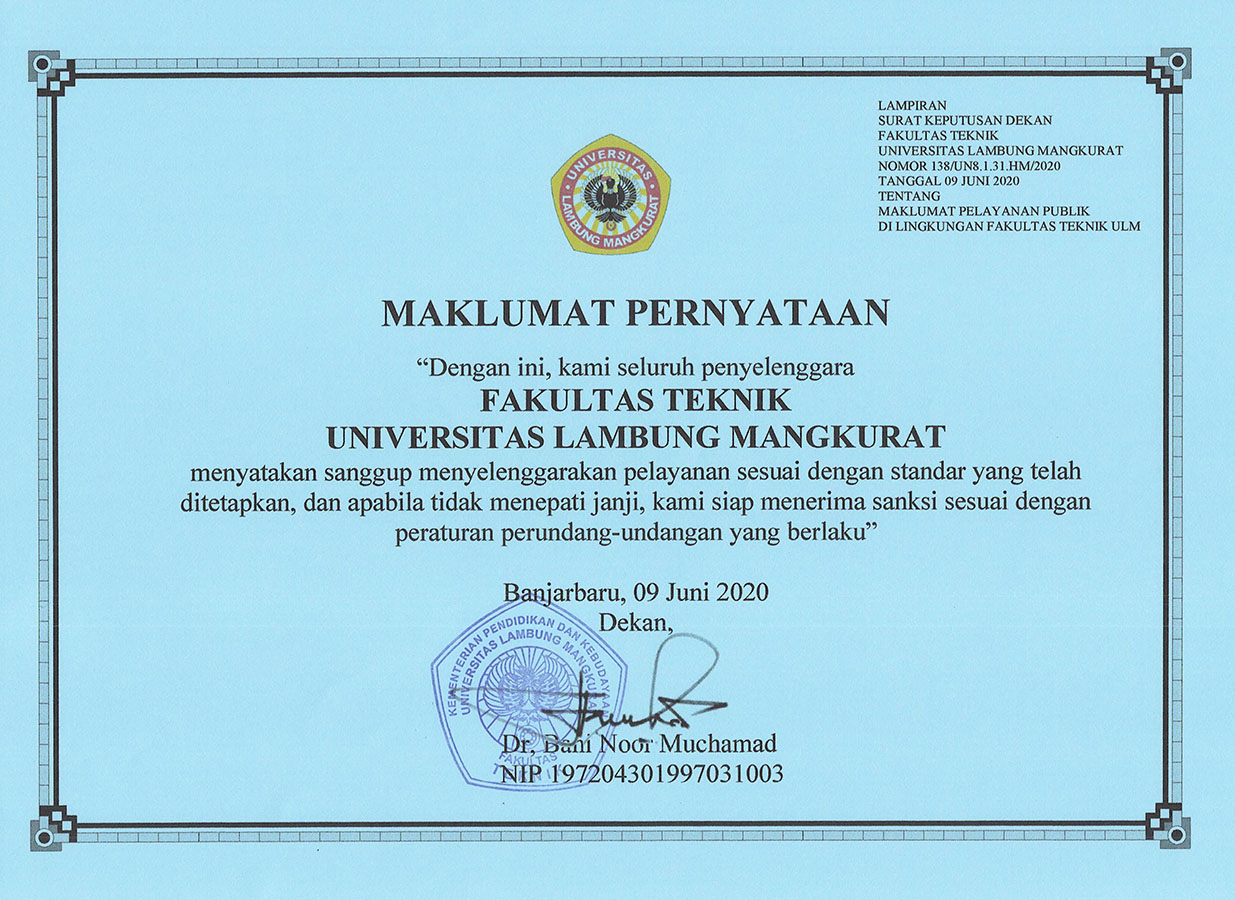
VI. Improving the Quality of Public Services
Innovation in the Area of Improving the Quality of Public Services:
(1) Innovation: all services are self-built (tailor made, free apps, and online).
(2) Change:
- Information becomes easier to know and be known by the public
- Efficiency of time, energy and costs (printing, materials, shipping) in every service
- Satisfaction evaluation (IKM) is more measurable and makes it easier to improve services
(3) Impact on public services: ease of accessing services and obtaining information.
1. Service Standards
Reference: Minister of Administrative and Bureaucratic Reform Decree No. 63/KEP/M.PAN/2003 regarding General Guidelines for the Provision of Public Services
Reference: Rector's Decree No. 1450/UN8/HM/2018 dated October 5, 2018 regarding Public Service Standards in the ULM Planning, Cooperation, and Public Relations Bureau.
Decree of the Dean of the Faculty of Engineering No. 137/UN8.1.31/HM/2020 concerning Public Service Standards within the Faculty of Engineering, Lambung Mangkurat University
Public Service Standards Document (SPP) within the Faculty of Engineering
Diploma Legalization Service Standards
Academic Transcript Legalization Service Standards
Service Standards for Legalization of Study Program Accreditation Certificates
Service Standards for Requesting a Certificate of Still Studying
Service Standards for Requests for Replacement Certificates for Academic Transcripts
Service Standards for Requests for Experts/Resources
SOP Evaluation Report Document (2019) by the FT Quality Assurance Unit
2. Excellent Service Culture
Activity regular socialization/training in an effort to implement Excellent Service Culture conducted by the Faculty of Engineering.
Service information is accessed via the FT website and FT IG
- System rewards has begun to be implemented through job promotions and work facility assistance.
- System punishment Currently, it is still prioritized by providing guidance to service implementers if the service does not meet standards because the ZI Development process is still in the early stages.
- FT has provided 39 (internal) services in an integrated manner in 1 service menu: https://ft.ulm.ac.id/id/layanan/
- FT has coordinated all information on space usage services https://ft.ulm.ac.id/id/sarpras/kalender-sarpras/
- FT has integrated the entire activity schedule https://ft.ulm.ac.id/id/profil/agenda/
- FT has integrated all correspondence services (disposition, assignment letters, outgoing letters, and permits)
Service innovations in the FT environment are:
1. Collaborative work system (Cloud & online).
- -Single data (same source)
- -Shared data (mutually complementary)
- -Work result standards (uniform)
2. Utilization of the G-Suite for Edu application in administrative services.
- -Already familiar (Docs; Sheet; Slide)
- -Tailor made based on job description.
- -Problem-specific solutions (growing applications)
- -Free of charge (Rp.0,-)
- -Time efficiency.
3. Single and integrated account system (@ulm.ac.id).
- -Centralized database (Drive & FT Server)
- -Ease of coordination (labels; groups)
- -Speed of information delivery (email)
4. Paperless Policy –> (disposition)
- -24×7 service (anytime & anywhere)
- -Easy and fast process control (can be traced at any time & easy search)
5. Online Lecturer & Education Staff Services
- -24×7 service (anytime & anywhere)
- -Makes reporting (performance) easier
- -Analysis (performance)
3. Assessment of satisfaction with services
Reference: Regulation of the Minister of Administrative and Bureaucratic Reform No. 14 of 2017 regarding Guidelines for Compiling Public Satisfaction Surveys of Public Service Provider Units.
- The public satisfaction survey regarding services at ULM was conducted by the ULM Public Relations unit..
- The survey was conducted annually since (2016 to 2019).
- At the Faculty of Engineering, the public satisfaction survey regarding services at FT is focused on: FT Graduate Users, FT Collaboration Partners, FT Alumni, and also parents of students.
Service Satisfaction Survey: https://ft.ulm.ac.id/id/survey-kepuasan-layanan/
Results of public satisfaction survey (Public Satisfaction Index) can be accessed openly via the ULM website (2016 – 2019): http://bpkh.ulm.ac.id/survei-kepuasan/
The results of the public satisfaction survey for services at the Faculty of Engineering can be accessed openly via the FT website:
https://ft.ulm.ac.id/id/tracer/
https://ft.ulm.ac.id/id/statistik-layanan/
Number of Survey Respondents (June 2020)
Distribution of Perception Values of Service Elements (June 2020)
IKM Service Unit (June 2020)
The follow-up to the results of the public satisfaction survey is the addition of the number of services (applications) according to business process needs, ease of service flow and process synchronization, increasing the information available and accessible, including all the required materials. can be obtained from one location.

